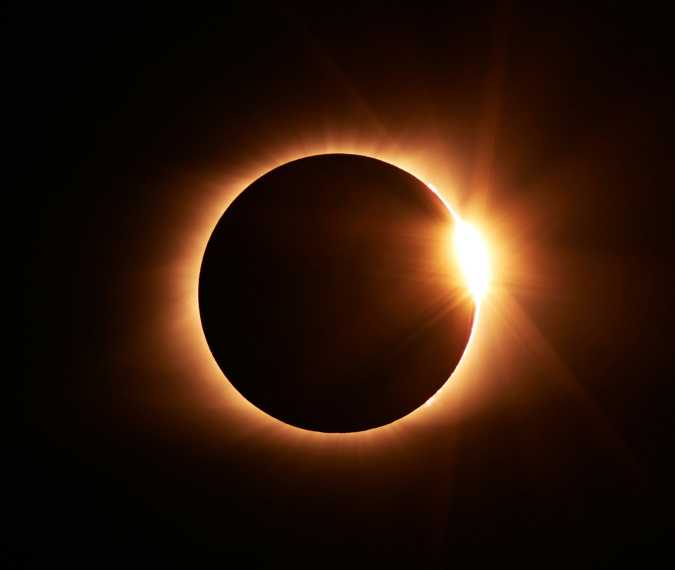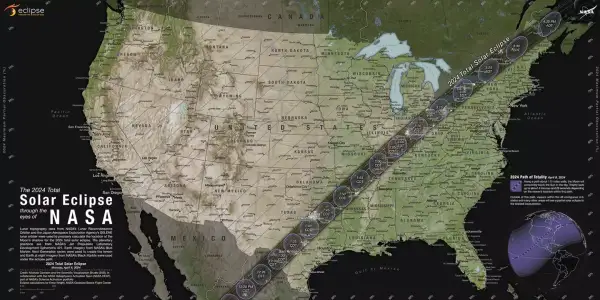
This is when the solar eclipse will be visible for you in your area
As dawn unfurls its golden hues, the advent of Monday is acknowledged with a collective sigh, marking the commencement of another week. Yet, an extraordinary phenomenon looms on the horizon, poised to envelop much of the United States in an ephemeral nocturnal cloak - a total solar eclipse is nigh.
Delving into the celestial mechanics of this phenomenon, a total solar eclipse emerges when the Moon, in its celestial journey, positions itself precisely between the Earth and the Sun. This alignment orchestrates a dramatic interplay of light and shadow, rendering the Sun's visage invisible, engulfed by the Moon's silhouette.
As the moment of totality approaches, an uncanny twilight will usurp the day, painting the sky in hues reminiscent of dawn or dusk. This spectacle, fervently awaited for weeks by enthusiasts and sky-watchers alike, promises a display of celestial majesty, marrying the predictable orbit of celestial bodies with the unpredictable awe of human observers.

Photo: unsplash.com/westcoastnoodle
In the quest to bear witness to the celestial dance, where the Sun momentarily succumbs to shadow, the urge to gaze skyward is instinctual. Yet, heed the counsel of NASA: such a spectacle demands respect, for the unshielded brilliance of the Sun brooks no direct gaze without the shield of appropriate armament.
Eclipse glasses, the guardians of sight in this event, are not mere tinted adornments but sentinels designed to fend off the Sun's overwhelming luminance. These are not your garden-variety spectacles but are forged for the sole purpose of solar observation, safeguarding your eyes from harm's way.
Yet, let not the absence of these guardians dismay you. Nor should you dare to confront the eclipse through the augmented gaze of a camera, binoculars, or a telescope unguarded by a solar filter—such recklessness invites peril to your vision.
For those without the means to don the protective eyewear or employ a device cloaked in a solar filter, creativity offers a refuge. A pinhole projector, simple in its construction, emerges as a beacon of ingenuity. By perforating a piece of cardstock or cardboard, you conjure a window through which the eclipse's silhouette can be safely observed, cast upon the ground or a surface, a diminutive yet profound echo of the cosmic spectacle above.

Photo: NASA
For a mobile-friendly or full-screen version of this interactive map, visit go.nasa.gov/EclipseExplorer.
Embarking from the vast, tranquil expanse of the South Pacific Ocean, the total solar eclipse is destined to carve a path of celestial awe across the globe. Its journey will usher it over the lands of Mexico, traverse the expansive tapestry of the United States, and finally grace Canada with its fleeting shadow.
This cosmic ballet offers the spectacle of totality exclusively to those fortunate to stand within its narrow corridor. Yet, the phenomenon extends its grace in the form of a partial eclipse to millions more, as the Moon etches its silhouette across the Sun's fiery canvas.
Inquiring minds eager to know when this celestial spectacle will grace their locale, particularly within the bounds of the Central Daylight Time Zone, should heed the following:
Fortune smiles upon those under clear skies, for the eclipse's shadow will first kiss the earth along Mexico’s Pacific coast, heralding totality at approximately 11:07am PDT. Its shadowy embrace will then sweep across into the United States, making its presence known in Texas at about 1:40pm CDT. Like a whispering shadow, it will glide over Idabel, Oklahoma, and Little Rock, Arkansas, within a span of 11 minutes, before the cloak of totality descends upon Poplar Bluff, Missouri at 1:56pm CDT.
The celestial spectacle continues its journey, reaching Carbondale, Illinois by 1:59pm CDT, then swiftly moving to Paducah, Kentucky a minute later, and finally casting Evansville, Indiana into twilight at 2:02pm CDT. This fleeting alignment, a confluence of celestial timing and terrestrial location, offers a rare glimpse into the cosmos’ grandeur, etching memories in the hearts of those who witness it.



